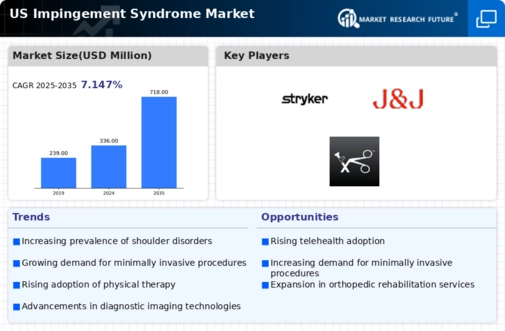Rising Incidence of Comorbidities
The impingement syndrome market is influenced by the rising incidence of comorbidities, particularly among the aging population. Conditions such as obesity, diabetes, and arthritis are increasingly prevalent, contributing to a higher risk of developing shoulder impingement syndrome. Data indicates that individuals with obesity are 50% more likely to experience shoulder pain, which can lead to impingement. As the population ages and the prevalence of these comorbidities rises, the demand for effective treatment options in the impingement syndrome market is expected to grow. Healthcare providers are likely to focus on integrated care approaches that address both the underlying comorbidities and the impingement syndrome itself. This holistic approach may enhance treatment efficacy and improve patient quality of life, thereby driving market growth.
Increased Focus on Sports Medicine
The impingement syndrome market is significantly impacted by the rising interest in sports medicine. As more individuals engage in physical activities and competitive sports, the incidence of shoulder injuries, including impingement syndrome, is likely to increase. Recent statistics suggest that sports-related injuries account for nearly 30% of all shoulder injuries, highlighting the need for effective treatment options. This trend is further fueled by the growing awareness of the importance of injury prevention and rehabilitation among athletes and fitness enthusiasts. Consequently, healthcare providers are increasingly investing in specialized training and resources to address these injuries, which may lead to a surge in demand for innovative treatments within the impingement syndrome market. The integration of sports medicine into mainstream healthcare is expected to enhance the visibility and accessibility of treatment options for affected individuals.
Expansion of Rehabilitation Services
The impingement syndrome market is experiencing growth due to the expansion of rehabilitation services tailored to shoulder injuries. As awareness of the importance of rehabilitation in recovery increases, more healthcare facilities are offering specialized programs for patients with impingement syndrome. These programs often include physical therapy, occupational therapy, and personalized exercise regimens designed to restore function and alleviate pain. The market for rehabilitation services is projected to grow at a CAGR of approximately 6% over the next five years, reflecting the increasing recognition of their role in effective treatment. Additionally, the integration of telehealth services into rehabilitation programs is likely to enhance accessibility for patients, further driving demand in the impingement syndrome market. This trend indicates a shift towards comprehensive care models that prioritize rehabilitation as a critical component of treatment.
Advancements in Diagnostic Techniques
The impingement syndrome market is benefiting from advancements in diagnostic techniques that enhance the accuracy and speed of identifying shoulder conditions. Innovations such as high-resolution MRI and ultrasound imaging allow for more precise assessments of impingement syndrome, leading to timely and effective treatment plans. These technologies not only improve patient outcomes but also reduce the overall healthcare costs associated with misdiagnosis or delayed treatment. As healthcare facilities adopt these advanced diagnostic tools, the market is likely to see an increase in patient referrals for specialized care. Moreover, the integration of artificial intelligence in imaging analysis may further streamline the diagnostic process, potentially increasing the number of patients diagnosed with impingement syndrome. This trend underscores the importance of accurate diagnostics in driving the growth of the impingement syndrome market.
Growing Demand for Non-Surgical Treatments
The impingement syndrome market is experiencing a notable shift towards non-surgical treatment options. Patients increasingly prefer conservative management strategies, such as physical therapy and corticosteroid injections, to avoid the risks associated with surgical interventions. This trend is supported by data indicating that approximately 70% of patients with shoulder impingement respond positively to non-invasive treatments. As healthcare providers emphasize patient-centered care, the demand for these alternatives is likely to rise, thereby influencing the overall market dynamics. Furthermore, the cost-effectiveness of non-surgical treatments, often ranging from $100 to $1,500, compared to surgical options that can exceed $10,000, makes them appealing to both patients and insurers. This growing preference for non-surgical solutions is expected to drive the impingement syndrome market forward in the coming years.














Leave a Comment